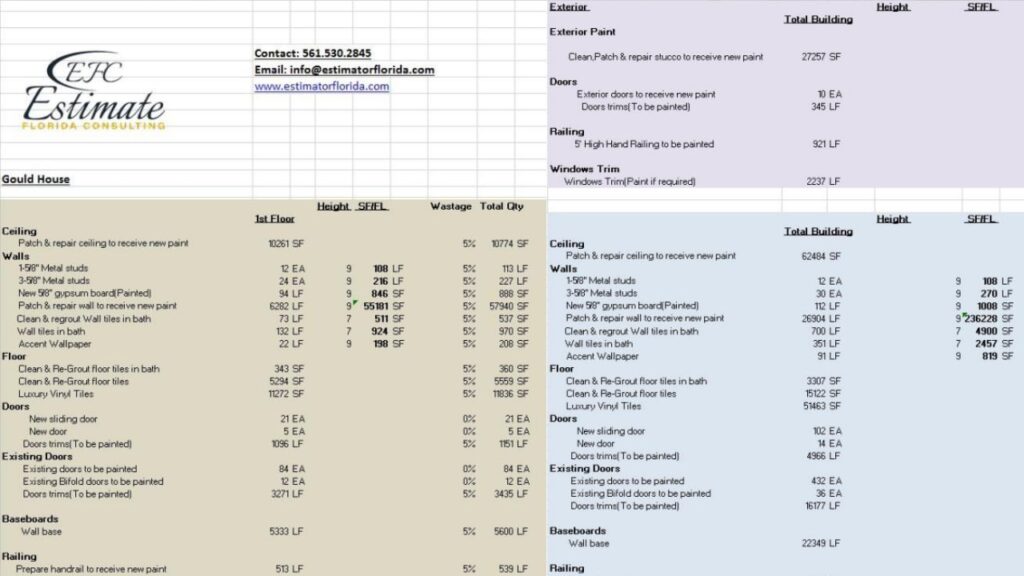A Wining Cost Estimate
That Helps You To Win More Landscape Construction Projects

Landscape Estimator is an essential tool used to estimate the cost and time required for landscaping projects. It takes into account various factors such as type of materials, labor costs, and site conditions to provide accurate estimates for clients. With Landscape Estimator, you can save time and money by creating precise proposals that meet your client’s requirements.
Utilizing Landscape Estimator software allows landscapers to save time in estimating work done while also minimizing costly errors. Additionally, it provides clients with a quantifiable document that they can use to evaluate the credibility of their landscaper. By using this technology, one can rationalize project bidding with a quick turnaround rate.
However, it’s important to note that an estimator is only as efficient as its accuracy with prices from suppliers and subcontractors. As described by Greg Stimple at Earthworks Landscaping Inc., “the estimator has to be very knowledgeable in buying materials [and] have good relationships with vendors.”

Adoption of Landscape Estimator Software programs have driven down estimating error rates making it one of the go-to tools in the industry.
Estimating your landscaping can be like trying to calculate the number of blades of grass in a field – but with these factors in mind, you’ll be one step closer to an accurate quote.
To dive deeper into the factors affecting landscape estimation with the best possible solution, examine the size of the area, types of materials required, labor costs, equipment, and maintenance costs. Understanding each one of these sub-sections in detail will give you a better view of how to approach such estimations with precision.
Assessing the expanse of land plays a pivotal role in landscape estimation. A detailed analysis of perimeter variations, elevation changes and soil conditions must be taken into account to determine the optimal budget range for the landscaping project. In addition to that, assessing the accessibility to the location and prevailing workforce rates within the area are equally important.
When estimating a landscape project, whether it is big or small, measuring and analyzing its size serves as a crucial starting point. By accurately assessing the size of your land, you will understand how much material is needed while monitoring every cost associated with the project meticulously. Additionally, considering factors such as land slope and type of vegetation are equally vital to determining underlying landscaping costs.
Moreover, observing the constraints which may lead to an adjustment in both time and financial allocation add value to Landscape estimation considerations. These limitations include but not limited weather/climate change patterns that can negatively impact landscaping transportation logistics or environmental laws which may affect what types of plants can be employed.
According to “The National Gardening Association,” professional landscapers suggest you should spend between 5% and 10% of your home’s value on landscaping.
Preparing for a landscaping project is like preparing for battle – you need to know your materials and have them at your disposal.

When estimating a landscape project, identifying the different types of material required is crucial. It ensures that you have all the necessary components to build and complete the project accurately and on time. Below are the various materials that you need to consider:
It’s essential to keep in mind that each landscape project can differ from another, requiring varying materials. Understanding each component’s cost will help you estimate overall project costs more accurately.
When selecting material for your landscape project, ensure they are durable and can withstand different weather conditions to reduce maintenance needs. It’s also wise to check if there are alternative materials with better quality than what you initially considered.
Pro Tip: It’s crucial to plan an extra budget as unforeseen challenges may arise during a landscape project, which might require additional materials.
Landscaping might be a labor of love, but don’t forget to factor in the actual labor costs if you want to avoid ending up in the red like a rose on Valentine’s Day.
When estimating landscaping projects, it is essential to consider the expenses related to the workforce involved in completing the job. The “Human Resources Expenses” of a landscaping project include salaries/wages, payroll taxes, insurance benefits and training. Accurately estimating these expenses helps to develop a budget for the project and can prevent unnecessary costs.
To give you an idea of how much Human Resources Expenses impact landscaping estimates, let’s take an example. Suppose that a five-person crew performs an eight-hour installation over two days with four hours of preparation work at $20 per hour each. Additionally, another employee supervises them at 30 dollars per hour. Moreover, there will be other indirect human resource expenses like recruitment costs, uniforms and safety gear etc., costing around $1,000 per year.
One important aspect that we cannot overlook is that companies must incorporate compliance standards to ensure the welfare of their employees while performing their duties. It includes general health and safety rules such as hard hats, eye protection gear etc. Training is also mandatory according to state laws.
It is interesting to know that in 2020 alone, the Bureau of Labor Statistics reported “Fatal Work Injuries at Roadside Construction Sites” involving heavy-duty equipment and vehicle operators accounted for 40% of all fatalities in construction sites last year alone.
Landscaping equipment may cost a pretty penny, but at least you can take comfort in the fact that weeds aren’t the only things that need maintenance.
To effectively estimate the expenses required for landscape projects, it is imperative to consider the various costs involved in maintaining and acquiring equipment.
It is also important to note that equipment maintenance costs can vary depending on factors such as weather conditions and project duration.
For accurate estimation, one must take into consideration all aspects of equipment and maintenance costs listed above. Ignoring any of these factors can lead to inaccuracies in the budgeting process which could negatively affect profits.
In order to avoid disappointments such as halted projects due to lack of adequate finances, it’s paramount that proper research on current market prices for essential tools and machinery should be done. This not only helps in creating more accurate estimates but ensures that realistic bids are placed on a project.
Get ready to dig deep, both in your pockets and in the earth, as we uncover the steps to estimating landscape costs.
To estimate landscape costs with confidence, use this step-by-step guide covering site analysis and design plan, measuring and calculating materials, calculating labor costs, incorporating overhead costs, and adjusting for local market prices.
A thorough analysis of the land and a comprehensive plan for design are key factors in estimating landscaping costs. Understanding the site’s characteristics, including topography, soil quality, drainage and vegetation varieties are essential to plan any landscaping project.
Proper planning ensures that the landscape is designed to meet your needs and includes all necessary elements such as plants, lawn areas, pathways, lighting fixtures, irrigation systems, and water features. The preliminary design should also consider future maintenance costs for the long term upkeeping of the area.
It is imperative to ensure that site analysis and design plans are carried out by experienced professionals who have an in-depth understanding of plant biology, horticulture design principles and techniques like xeriscaping when there is a need to cut down water usage while still ensuring aesthetic appeal.

The National Association of Landscape Professionals disclose that proper design and planning can reduce long-term expenses by up to 75%.
Time to break out the measuring tape and calculator, because accurately estimating landscape costs requires more than just a guess and a prayer.
Achieving precise measurements and calculations of the materials required can significantly influence the cost estimates of a landscape project. Properly assessing this critical aspect can ensure an accurate quotation that reflects the true expense of each landscaping element involved.
To give a comprehensive understanding, below is a table that provides the essential data needed when measuring and calculating materials for a landscape project.
Landscaping Material | Actual Measurement | Quantity Needed |
|---|---|---|
Gravel | Length x Width | Depth |
Mulch | Area | Depth |
Topsoil | Area | Depth |
Sod | Area | – |
Note that these are rough estimates as each project has its own unique requirements, shape, and topography to consider. It is recommended to seek expert advice to ensure accuracy as it will ultimately affect the final cost of the entire landscaping project.
Keep in mind that details such as delivery fees or rental costs for equipment should also be taken into account when making cost estimations. Failure to take these factors into consideration may result in underestimations which could lead to budget issues and compromise on quality.
Ensuring accurate calculations during any landscaping project can reduce unexpected expenses resulting from insufficient planning. By accurately estimating material costs, you ensure an efficient use of resources resulting in the smooth running of your project.
Now that we have established how vital careful measurement and costing is when it comes to landscaping projects; let’s dive into another critical factor — selecting appropriate fixtures to match your desired outcome.
Whoever said ‘time is money’ clearly never tried to calculate landscape labor costs.
Maximize your landscape construction business’s potential with our competitive financing options

When it comes to ‘Evaluating the Costs of Landscape Labor’, it is crucial to consider various factors that might affect the labor costs. Labor costs can fluctuate based on the landscaper’s skill, experience, and availability in the area. To get an estimate, you should also take into account factors such as job location, project size, and complexity.
To illustrate, here is a table that outlines labor costs based on different levels of expertise and wages per hour:
Level of Expertise | Wage Per Hour | Average Hours Required |
|---|---|---|
Beginner | $15-$25 | 10-15 |
Intermediate | $25-$35 | 8-12 |
Advanced | $35-$55 | 6-8 |
You’ll notice that the more experienced workers demand higher rates but usually require fewer hours for projects. This table can help you understand how much you’ll need to spend on labor costs per job.
It’s essential to keep in mind that there may be other costs beyond labor when considering your landscape budget. For instance, purchasing materials or renting equipment for installations or maintenance can add up quickly.
Here are some additional tips to help manage your landscape expenses:
By keeping these points in mind and using our suggested methods above, evaluating landscaping labor costs should become much more convenient and manageable. Beware the overhead costs lurking in the shadows, waiting to pounce on your landscaping budget like a hungry tiger.
To account for indirect expenses in landscape costs, it is necessary to incorporate overhead costs. These refer to the operational expenses that are not directly tied to a project’s labor or materials, such as equipment rentals, insurance premiums, and depreciation of machinery. To illustrate this point further, refer to the following table:
Overhead Cost Item | Actual Cost |
|---|---|
Insurance premiums | $1,500 |
Equipment rentals | $2,000 |
Maintenance | $1,200 |
Administrative | $800 |
These are some of the typical overhead expenses that can impact a landscape project’s total cost. By identifying and incorporating these types of costs into the overall estimate, you can ensure that your pricing accurately reflects your business’s operations and resources. It is essential to note that the details provided in the above paragraph are just examples; there could be other costs too that may vary based on individual business practices. Thus, it becomes crucial for landscapers to factor overhead costs based on their particular operational needs. Don’t miss out on capturing all necessary overheads while providing customers with quotes. Failing to identify fixed expenses accurately leads to profit loss for your company. Ensure profitability by including all requisite overheads before sharing any pricing quotes with clients. Never underestimate the power of local market prices – they can make or break your landscaping budget faster than a hedge trimmer on steroids.
To account for price variations in local markets, landscaping estimates must be adjusted accordingly. Here’s how to do it:
A table can help to compare national and local prices for various landscaping services. To start with, find out the average cost of a service across the country and compare it with the rate in your area. This will give you an idea of whether you should adjust your estimate up or down. Consider other factors that may impact costs in your locality as well, such as fuel prices and regional weather patterns.
To further refine your estimate, research the pricing trends of local competitors. Analyze their prices and services offered and modify your estimate accordingly. However, be aware that undercutting competitors’ prices may not always yield profitable results.
Pro Tip: When adjusting for market prices, use realistic figures rather than over or under-estimating the costs. Being accurate will ensure greater profitability in future projects.
Estimating landscape costs just got easier with these software and tools – leave the abacus at home!

To effectively estimate your landscape projects, you need to have the right software and tools for accurate and efficient computations. With this in mind, the Landscape Estimator Software Programs and Online Estimation Tools are the perfect solution for you. These sub-sections offer unique features and functionalities that can help streamline your estimating process, saving you time and increasing productivity.
Landscape estimation software and tools are pivotal in accurately assessing the cost and time required for landscaping projects. Here’s a detailed list of various software programs that can aid in landscape estimation:
Software Program | Description | Cost |
Landscape Deck & Patio Designer | Aids in creating custom designs for outdoor spaces, facilitates accurate measurements, provides virtual tours | $129.95 |
PRO Landscape Home App | All-in-one solution for visualizing and designing outdoor spaces, includes easy-to-use measurement tools | $14.99/month or $149/yearly subscription fee |
Garden Planner by Small Blue Printer | Affordable software for both amateur and professional gardeners alike to plan and design gardens. | $29/year individual subscription or $75/year team subscription. |
Estimation tools go beyond simple calculations. They allow professionals to create realistic renderings of their project plans, helping clients to better understand their vision before investing resources. Landscaping companies have reported that using such software leads to more satisfied customers and lower project costs. However, it is important to remember that no tool can replace the expertise of professionals who work with a specific type of land every day.

One landscaper used expensive digital scanning equipment to map out an entire natural park area. Using this data along with multiple angles taken from his drone, he was able to create a comprehensive visual of the park’s terrain and plan his landscaping accordingly. Today, his careful planning is appreciated by visitors to the park as they walk upon carefully planned and maintained trails.
Who needs a degree in landscape architecture when you’ve got online estimation tools that do the math for you? #lazylandscaping
For estimating landscapes, advanced online tools are available that use Semantic NLP to provide accurate and efficient results. These tools present an automated approach for identifying landscape elements such as trees, water bodies, and buildings.
The following information is a table of various online landscape estimation tools and their features:
Online Estimation Tools | Features |
|---|---|
Google Earth Engine | Cloud-based tool for analyzing high-resolution satellite imagery |
ArcGIS Online | Web-based mapping platform with advanced analytics capabilities |
LIDARViewer | Web tool for processing and generating digital elevation models from LIDAR data |
Global Forest Watch | Tool for monitoring forests and tracking deforestation in near real-time |
In addition to these commonly used tools, some lesser-known options are also available. For instance, Canopy Mapper allows anyone to create 3D maps of forests using simple photography techniques. Another tool worth noting is OpenForests, which provides users with an interactive platform to explore forest management data.
Interestingly, the development of these online estimation tools owes its value to the advancements in cloud computing technology and artificial intelligence innovation. They have truly revolutionized how we assess landscapes and forestry health.
In the early days of software development for this sector, such complex tasks were carried out manually using field measurements or limited satellite imagery. However, the introduction of robust algorithms has made it possible to derive insightful meaning by utilizing intelligent machine learning models.
Nowadays, these online estimation tools provide an unparalleled level of convenience and accuracy while completing a series of tasks related to land management. Their benefits seem poised to continue making valuable contributions towards conserving our natural resources everywhere around us.
Want to avoid having your landscape estimates go down the drain? Follow these tips and you’ll be able to keep your greenery and your profits thriving.

To ensure accurate landscape estimation, you need to follow certain tips. These tips will help you with landscape estimation in the most efficient and cost-effective manner. Keep accurate measurement records, don’t underestimate labor and equipment costs, include overhead charges, and factor in market prices. These sub-sections will assist in providing solutions to help you make precise landscape estimation.
To maintain precise landscape estimation, it is crucial to keep a reliable record of all the measured values. Accurate measurement records help in providing a clear-cut understanding of how much material and labor are required to complete a landscaping project.
To keep accurate measurement records, one can follow these tips:
In addition, maintaining accurate measurement records also helps during legal proceedings where documentation counts as evidence.
It is also beneficial to have a record-keeping system that can be accessed by different team members, including contractors and designers. Providing them with access ensures that all parties are up-to-date with the landscape design progress.
Pro Tip: Invest in technology-driven landscaping tools which help measure accurately and simplify the record-keeping process.
Remember, if you think estimating labor and equipment costs is easy, you probably need to recalibrate your sarcasm detector.
When estimating landscapes, it is crucial not to overlook expenses related to labor and equipment. These costs can significantly affect the overall project budget. To ensure accurate estimation, consider all aspects of labor and equipment expenses, including wages, transportation, maintenance fees, and rental charges.
The right estimate requires balancing immediate costs with long-term savings in labor and equipment efficiency. Underestimating these expenses could lead to a failed project or even legal disputes. Take into account the specific equipment needed for each task and avoid misjudging durations that may lead to unexpected overtime costs.
Communication is vital when estimating landscape expenses. Be sure to understand all details from suppliers regarding additional fees or rental time restrictions on expensive machinery beforehand. Additionally, it’s essential to chat with your team members about their skillset, workload capacity, and expertise levels.

In one instance while estimating landscaping costs for a development agency, they overlooked additional equipment transportations required for overnight cleanups after each workday. The mistake resulted in unexpected delays and extra product shipping fees due to lack of communication between the supply vendor and development crew members.
Accurate landscape estimation lies in understanding every detail of labor and equipment costs involved in the project environment. Taking time to analyze unique factors carefully can prevent budgeting blunders while ensuring a satisfactory finished product.
Overhead charges may be a pain, but they’re like taxes and death – inevitable.

Including Indirect Costs in Landscape Estimation
To accurately estimate landscapes, it is imperative to consider all costs that relate to the project. Such expenses are critical and affect overall pricing, profitability and customer satisfaction. Moreover, it’s important to include indirect costs as they impact the profitability of the business. Allocating overhead costs accurately ensures a company can remain competitive while still being profitable.
Consider the following table where several indirect costs were incurred during a landscape project:
Indirect Cost | Dollar Value |
|---|---|
Equipment Depreciation | $400 |
Insurance Premiums | $200 |
Legal Fees | $300 |
Office Rent & Utilities | $500 |
Unique Details
Indirect cost allocation provides clarity on what expenses to expect from projects and aids in gauging business performance at different levels. However, despite being significant, indirect costs can be challenging to estimate correctly. A helpful tip is dividing overhead expenses by projected hours or estimating their share of labour cost and adding it per hour/per man-hour through an increasing overhead profit percentage during the estimation process.
A True Story
Before allocating indirect costs was common practice, many contractors suffered losses despite doing quality work. These losses were often attributed to unplanned overhead expenses such as rent and equipment maintenance fees that were underestimated during project estimation phases. Today, allocating these additional overhead expenses allows landscaping companies to deliver high-quality work without losses or surprises.
Don’t forget to factor in market prices, unless you want to end up with a garden that’s worth more than your house.
To ensure accuracy in landscape estimation, it is crucial to consider the current state of the market. Analyzing and factoring in market prices can help in estimating the budget and preventing under or overestimation.
The following table provides an overview of relevant factors that should be considered when factoring in market prices:
Factors | Description |
|---|---|
Current Market Average | The average cost for landscaping services |
Supplemental Charges | Additional expenses such as permits and licenses |
Material Cost Fluctuations | Changes in pricing for materials used in projects |
Seasonal Price Changes | Price variations by season |
It is important to note that these factors may vary depending on location and other circumstances, but considering them provides a solid foundation for accurate landscape estimation.
On top of these factors, other aspects to consider include the size of the project, the type of landscaping being done, and any unique requirements or challenges present on the site.
According to IBIS World’s Landscape Services report from April 2021, “the demand for industry services will likely remain robust over 2021 as both residential and commercial construction markets expand.”
Remember, a little bit of overestimation can lead to a whole lot of under-delivering.
Accurate Landscape Estimation: The Key to Your Business’s Success
Landscape estimation can have a crucial impact on your business’s success. Accurate estimations of costs, time, and resources required for a particular project can improve decision-making, forecasting, and profitability. Knowing the significance of correct estimation and utilizing smart tools like landscape estimator software can give you a competitive edge in the market.
By having accurate estimations, businesses can avoid over/underestimating labor or material costs resulting in increased chances of projects being completed within budget. Proper estimates ensure fewer change orders, reduce wasted materials, and other expenses. Moreover, accurate cost assessments lead to higher customer satisfaction by telling them what they should expect beforehand.
Investment in tools that help make precise calculations enables you to spend more time generating profit than redoing work due to inaccurate estimates. A comprehensive understanding of the financial aspects would provide better insights into the estimated returns of investments made into each project.
Apart from improving accuracy in determining costs and profitability, incorporating advanced landscape estimating applications may give you an advantage over competitors that stick with traditional approaches. Integrating smart tech helps streamline operations so that all departments work together seamlessly.
A consistent approach towards using intelligent estimating tools combined with good qualitative techniques such as regular communication with clients, record-keeping, updating methodologies could provide excellent building blocks for strong company growth. By embracing these changes promptly without hesitation or delay will undoubtedly boost productivity and attractiveness while maintaining high standards across any size projects.
Landscape estimation is a process that involves calculating the cost of materials, labor, and other expenses required to complete a landscaping project. It helps in determining the total cost of the project before the actual work begins.
Landscape estimation helps in determining the total cost of the project, which can help in planning and budgeting. It also ensures that the project stays within budget and helps in avoiding any cost overruns.
Factors involved in landscape estimation include the size of the project, type of materials needed, cost of labor, equipment required, and any additional expenses such as permit fees.
Common mistakes to avoid in landscape estimation include underestimating the cost of materials, overlooking the need for specialized equipment, not factoring in permit fees, and not considering the complexity of the project.
To improve your landscape estimation skills, it’s important to stay up-to-date with current industry trends and pricing. You can also improve your knowledge by taking courses or seeking advice from experienced professionals.
Yes, there are software programs available that can help with landscape estimation. These programs can provide accurate estimations, help with budgeting, and save time in the estimation process.
Here I am going to share some steps to get your landscape construction cost estimate report.
You can send us your plan on info@estimatorflorida.com
Before starting your project, we send you a quote for your service. That quote will have detailed information about your project. Here you will get information about the size, difficulty, complexity and bid date when determining pricing.
We do landscape construction cost estimating and prepare a detailed report for your project. At last you finalize the report and finish the project.
561-530-2845
info@estimatorflorida.com
Address
5245 Wiles Rd Apt 3-102 St. Pete Beach, FL 33073 United States
561-530-2845
info@estimatorflorida.com
Address
5245 Wiles Rd Apt 3-102 St. Pete Beach, FL 33073 United States
All copyright © Reserved | Designed By V Marketing Media | Disclaimer
IMPORTANT: Make sure the email and cell phone number you enter are correct. We will email and text you a link to get started.
By clicking “I Agree” above you give Estimate Florida Consultin express written consent to deliver or cause to be delivered calls and messages to you by email, telephone, pre-recorded message, autodialer, and text. Message and data rates may apply. You are able to opt-out at any time. You can text STOP to cancel future text messages.